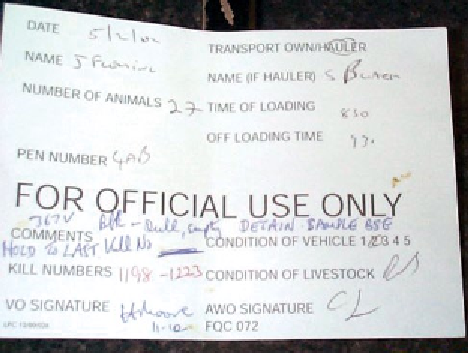Agriculture Reference
In-Depth Information
Table 9.1
USDA/FSIS data on carcase condemnation of dairy
cows 2005-2007
Ante-mortem failure
0.8% of total
Post-mortem failure 3.04%
of total
Dead
62.5%
Malignant
lymphoma
26.9%
Non-ambulatory
or moribund
35.0%
Pneumonia
13.1%
Epithelioma
0.8%
Septicaemia
10.2%
Pneumonia
0.5%
Peritonitis
8.9%
Pyrexia
0.3%
Pericarditis
6.8%
Figure 9.4
Example of a pen card system (Reproduced with
permission from Harold Moore).
An
accident
is defined as 'a specific, identifiable, unex-
pected, unusual and unintended external action which
occurs in a particular time and place, without apparent or
deliberate cause but with marked effects or alternatively as
an unforeseen or unexpected event especially one causing
loss or damage'. Examples of accidents may include
fractured limbs; road traffic accidents; serious lacerations
or injuries from, for example, feed shear grabs; 'bulling
injuries' and 'doing the splits'; serious haemorrhage;
obturator paralysis assessed immediately post calving; or
clearly identifiable spinal injury from an accident.
Emergency slaughter animals
An exception to the general rule that only live animals be
accepted into the slaughterhouse for human consump-
tion permits the emergency slaughter of livestock
elsewhere. This has gained importance thanks to the
improvements made to tighten up the rules on the wel-
fare during transport of animals within the EU which
has virtually eliminated what was once common practice -
the transportation of acutely lame or recumbent animals
to the meat plant. Historically, this was particularly a
problem with post-parturient dairy cows, cull sows and
pork pigs with vertebral abscess as a result of tail biting.
Data from the United States, 2005-2007, show that
under the USDA/FSIS system (White and Moore, 2009),
0.8% of cows sent for slaughter were condemned during
ante-mortem inspection and 3.04% at post-mortem
(Table 9.1).
These figures demonstrate the extent of the problem
of transporting end-of-use cull dairy cows.
As a guide to frequency of occurrence of emergency
slaughter, Northern Ireland, with a cattle population of
1.7 million, had during the years 2010 and 2011 approxi-
mately 500 carcases presented as having had on-farm
emergency slaughter carried out.
Under current rules, meat from a red meat animal that
has undergone
emergency
slaughter outside the slaugh-
terhouse may only be used for human consumption if it
is from 'an otherwise
healthy
animal that has suffered an
accident
that prevented its transport to the slaughter-
house for welfare reasons. Animals cannot be trans-
ported for welfare reasons if, under one definition, it
cannot walk unaided or under alternative it cannot bear
weight on all four limbs.
Emergency
implies that slaughter takes place as a result
of an event requiring immediate attention.
Emergency slaughter: The decision on farm
If a farmer considers that an animal which has had an
accident may still be suitable for food, he should seek the
advice of his private veterinary practitioner. It is the
responsibility of the veterinary practitioner to confirm
whether or not the animal is suitable for food, taking
into consideration its clinical history, clinical signs and
history of veterinary medicines administered and the
required withdrawal periods.
The veterinarian may decide on one of the three
options:
1
The animal is fit to be transported alive to the slaugh-
terhouse for human consumption accompanied by
complete food chain information.
2
The animal may be slaughtered on farm, or elsewhere
outside the slaughterhouse, and the carcase trans-
ported to the slaughterhouse, accompanied by
complete food chain information supplemented by a
veterinary declaration.
3
The animal may be slaughtered and disposed of as
animal by-product, remembering that currently
within the EU, bovines over 48 moths must be sam-
pled and tested for BSE.
Having confirmed that the animal is fit for food, is
healthy, is not emaciated, is clean enough to be sent to a













